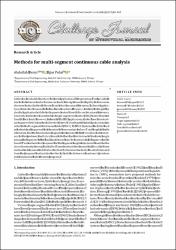| dc.contributor.author | Demir, Abdullah | |
| dc.contributor.author | Polat, Uğur | |
| dc.date.accessioned | 2023-09-08T09:03:40Z | |
| dc.date.available | 2023-09-08T09:03:40Z | |
| dc.date.issued | 2023 | en_US |
| dc.identifier.issn | 2149-8024 | |
| dc.identifier.uri | http://doi.org/10.20528/cjsmec.2023.02.001 | |
| dc.identifier.uri | https://hdl.handle.net/20.500.12573/1772 | |
| dc.description.abstract | Cables are invaluable members for some applications of engineering. The specialty is
due to its behavior under transverse loads. Having almost no rigidity in transverse
direction makes cables different from other structural elements. In most applications, cables are assumed to be two force members. However, not only its weight but
also its application with roller supports makes them different structural elements.
Generally, cables are assembled as single-segmented cables (SSC) where they are
fixed at their ends. However, in most of the SSC applications, cables have intermediate supports which can be rollers or sliders. These type of cable applications are
called as multi-segment continuous cables (MSCC). In MSCC systems, the cable fixed
at its ends and supported by a number of intermediate rollers. Total length of cable
is constant, and the intermediate supports are assumed to be frictionless and stationary. In this problem, the critical issue is to find the distribution of the cable length
among the segments in the final equilibrium state, so reactions at all supports can be
found. Two methods are proposed for the segment length adjustment based on the
stress continuity among the cable. These methods are named as direct stiffness
method and tension distribution method (relaxation method). Results calculated
from the proposed methods are verified by both the reference benchmark problems
and commercial finite element program | en_US |
| dc.language.iso | eng | en_US |
| dc.publisher | Tulpar Academic Publishing | en_US |
| dc.relation.isversionof | 10.20528/cjsmec.2023.02.001 | en_US |
| dc.rights | info:eu-repo/semantics/openAccess | en_US |
| dc.subject | Tensegrity | en_US |
| dc.subject | Single-segment cable | en_US |
| dc.subject | Multi-segment cable | en_US |
| dc.subject | Direct stiffness method | en_US |
| dc.subject | Tension distribution method | en_US |
| dc.title | Methods for multi-segment continuous cable analysis | en_US |
| dc.type | article | en_US |
| dc.contributor.department | AGÜ, Mühendislik Fakültesi, İnşaat Mühendisliği Bölümü | en_US |
| dc.contributor.authorID | 0000-0002-6392-648X | en_US |
| dc.contributor.institutionauthor | Demir, Abdullah | |
| dc.identifier.volume | 9 | en_US |
| dc.identifier.issue | 2 | en_US |
| dc.identifier.startpage | 48 | en_US |
| dc.identifier.endpage | 54 | en_US |
| dc.relation.journal | Challenge Journal of Structural Mechanics | en_US |
| dc.relation.publicationcategory | Makale - Uluslararası Hakemli Dergi - Kurum Öğretim Elemanı | en_US |


















